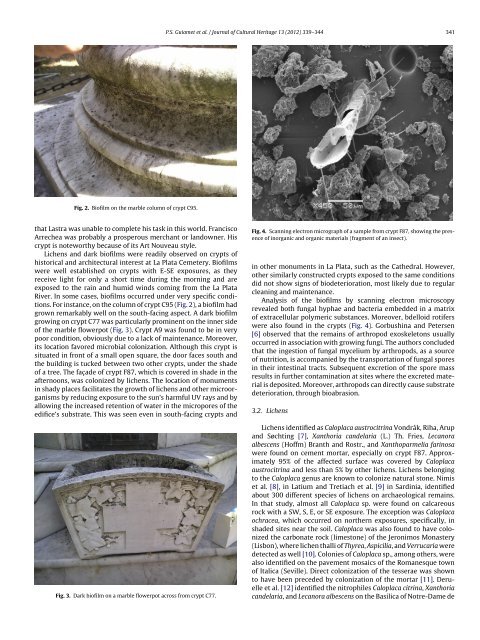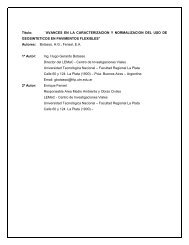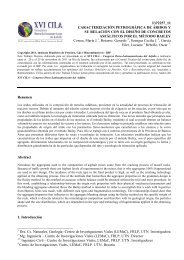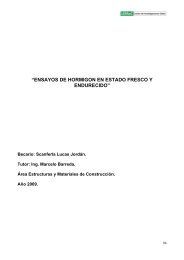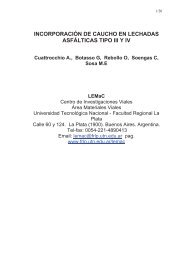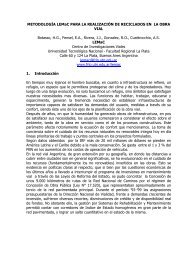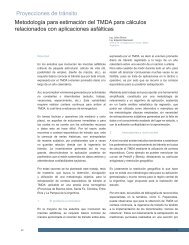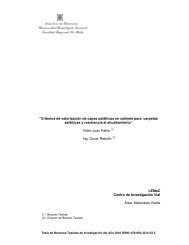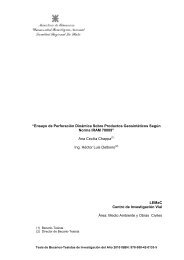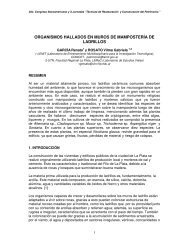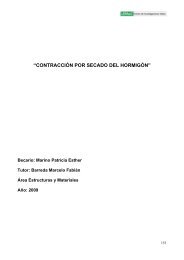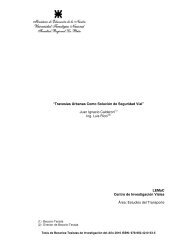Biofouling of crypts of historical and architectural interest at La Plata ...
Biofouling of crypts of historical and architectural interest at La Plata ...
Biofouling of crypts of historical and architectural interest at La Plata ...
You also want an ePaper? Increase the reach of your titles
YUMPU automatically turns print PDFs into web optimized ePapers that Google loves.
Fig. 2. Bi<strong>of</strong>ilm on the marble column <strong>of</strong> crypt C95.<br />
th<strong>at</strong> <strong>La</strong>stra was unable to complete his task in this world. Francisco<br />
Arrechea was probably a prosperous merchant or l<strong>and</strong>owner. His<br />
crypt is noteworthy because <strong>of</strong> its Art Nouveau style.<br />
Lichens <strong>and</strong> dark bi<strong>of</strong>ilms were readily observed on <strong>crypts</strong> <strong>of</strong><br />
<strong>historical</strong> <strong>and</strong> <strong>architectural</strong> <strong>interest</strong> <strong>at</strong> <strong>La</strong> Pl<strong>at</strong>a Cemetery. Bi<strong>of</strong>ilms<br />
were well established on <strong>crypts</strong> with E-SE exposures, as they<br />
receive light for only a short time during the morning <strong>and</strong> are<br />
exposed to the rain <strong>and</strong> humid winds coming from the <strong>La</strong> Pl<strong>at</strong>a<br />
River. In some cases, bi<strong>of</strong>ilms occurred under very specific conditions.<br />
For instance, on the column <strong>of</strong> crypt C95 (Fig. 2), a bi<strong>of</strong>ilm had<br />
grown remarkably well on the south-facing aspect. A dark bi<strong>of</strong>ilm<br />
growing on crypt C77 was particularly prominent on the inner side<br />
<strong>of</strong> the marble flowerpot (Fig. 3). Crypt A9 was found to be in very<br />
poor condition, obviously due to a lack <strong>of</strong> maintenance. Moreover,<br />
its loc<strong>at</strong>ion favored microbial coloniz<strong>at</strong>ion. Although this crypt is<br />
situ<strong>at</strong>ed in front <strong>of</strong> a small open square, the door faces south <strong>and</strong><br />
the building is tucked between two other <strong>crypts</strong>, under the shade<br />
<strong>of</strong> a tree. The faç ade <strong>of</strong> crypt F87, which is covered in shade in the<br />
afternoons, was colonized by lichens. The loc<strong>at</strong>ion <strong>of</strong> monuments<br />
in shady places facilit<strong>at</strong>es the growth <strong>of</strong> lichens <strong>and</strong> other microorganisms<br />
by reducing exposure to the sun’s harmful UV rays <strong>and</strong> by<br />
allowing the increased retention <strong>of</strong> w<strong>at</strong>er in the micropores <strong>of</strong> the<br />
edifice’s substr<strong>at</strong>e. This was seen even in south-facing <strong>crypts</strong> <strong>and</strong><br />
Fig. 3. Dark bi<strong>of</strong>ilm on a marble flowerpot across from crypt C77.<br />
P.S. Guiamet et al. / Journal <strong>of</strong> Cultural Heritage 13 (2012) 339–344 341<br />
Fig. 4. Scanning electron micrograph <strong>of</strong> a sample from crypt F87, showing the presence<br />
<strong>of</strong> inorganic <strong>and</strong> organic m<strong>at</strong>erials (fragment <strong>of</strong> an insect).<br />
in other monuments in <strong>La</strong> Pl<strong>at</strong>a, such as the C<strong>at</strong>hedral. However,<br />
other similarly constructed <strong>crypts</strong> exposed to the same conditions<br />
did not show signs <strong>of</strong> biodeterior<strong>at</strong>ion, most likely due to regular<br />
cleaning <strong>and</strong> maintenance.<br />
Analysis <strong>of</strong> the bi<strong>of</strong>ilms by scanning electron microscopy<br />
revealed both fungal hyphae <strong>and</strong> bacteria embedded in a m<strong>at</strong>rix<br />
<strong>of</strong> extracellular polymeric substances. Moreover, bdelloid rotifers<br />
were also found in the <strong>crypts</strong> (Fig. 4). Gorbushina <strong>and</strong> Petersen<br />
[6] observed th<strong>at</strong> the remains <strong>of</strong> arthropod exoskeletons usually<br />
occurred in associ<strong>at</strong>ion with growing fungi. The authors concluded<br />
th<strong>at</strong> the ingestion <strong>of</strong> fungal mycelium by arthropods, as a source<br />
<strong>of</strong> nutrition, is accompanied by the transport<strong>at</strong>ion <strong>of</strong> fungal spores<br />
in their intestinal tracts. Subsequent excretion <strong>of</strong> the spore mass<br />
results in further contamin<strong>at</strong>ion <strong>at</strong> sites where the excreted m<strong>at</strong>erial<br />
is deposited. Moreover, arthropods can directly cause substr<strong>at</strong>e<br />
deterior<strong>at</strong>ion, through bioabrasion.<br />
3.2. Lichens<br />
Lichens identified as Caloplaca austrocitrina Vondrák, Riha, Arup<br />
<strong>and</strong> Søchting [7], Xanthoria c<strong>and</strong>elaria (L.) Th. Fries, Lecanora<br />
albescens (H<strong>of</strong>fm) Branth <strong>and</strong> Rostr., <strong>and</strong> Xanthoparmelia farinosa<br />
were found on cement mortar, especially on crypt F87. Approxim<strong>at</strong>ely<br />
95% <strong>of</strong> the affected surface was covered by Caloplaca<br />
austrocitrina <strong>and</strong> less than 5% by other lichens. Lichens belonging<br />
to the Caloplaca genus are known to colonize n<strong>at</strong>ural stone. Nimis<br />
et al. [8], in L<strong>at</strong>ium <strong>and</strong> Tretiach et al. [9] in Sardinia, identified<br />
about 300 different species <strong>of</strong> lichens on archaeological remains.<br />
In th<strong>at</strong> study, almost all Caloplaca sp. were found on calcareous<br />
rock with a SW, S, E, or SE exposure. The exception was Caloplaca<br />
ochracea, which occurred on northern exposures, specifically, in<br />
shaded sites near the soil. Caloplaca was also found to have colonized<br />
the carbon<strong>at</strong>e rock (limestone) <strong>of</strong> the Jeronimos Monastery<br />
(Lisbon), where lichen thalli <strong>of</strong> Thyrea, Aspicilia, <strong>and</strong> Verrucaria were<br />
detected as well [10]. Colonies <strong>of</strong> Caloplaca sp., among others, were<br />
also identified on the pavement mosaics <strong>of</strong> the Romanesque town<br />
<strong>of</strong> Italica (Seville). Direct coloniz<strong>at</strong>ion <strong>of</strong> the tesserae was shown<br />
to have been preceded by coloniz<strong>at</strong>ion <strong>of</strong> the mortar [11]. Deruelle<br />
et al. [12] identified the nitrophiles Caloplaca citrina, Xanthoria<br />
c<strong>and</strong>elaria, <strong>and</strong> Lecanora albescens on the Basilica <strong>of</strong> Notre-Dame de


